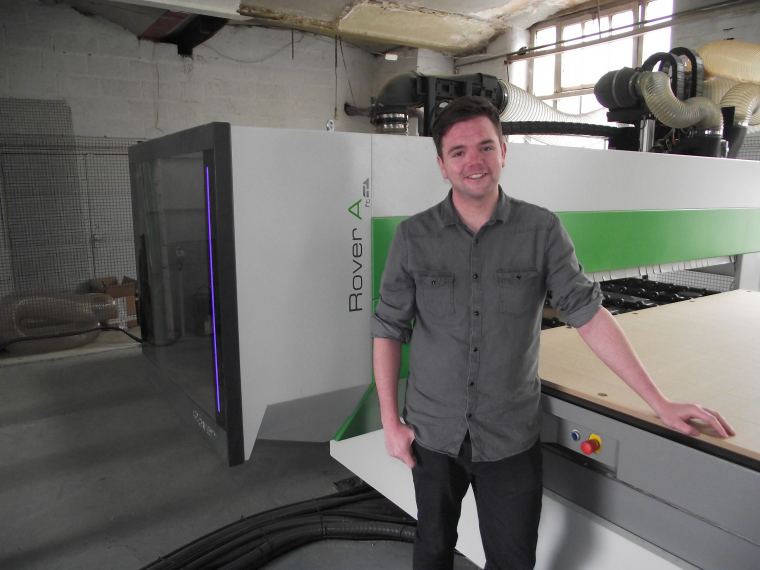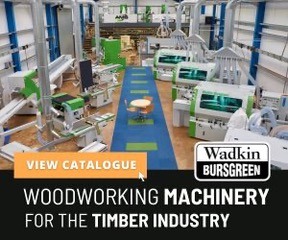The company manufactures cabinets for around 200 kitchens and bedrooms a month, and says Cabinet Vision, from Vero Software, has been key to doubling its output within six months of installing it, and enabling them to offer a fully bespoke service.
Before upgrading its CNC machinery with a Biesse flat top nesting machine, and investing in Cabinet Vision Solid Ultimate with Label-IT and Screen-To-Machine at the same time late last year, Crown produced its cabinets on a point-to-point machine.
“A standard eight-to-ten-cabinet kitchen used to take at least two hours…now it takes me about 15 minutes to optimise. We’re averaging eight full jobs a day, compared to four previously. And we now have the capacity to accommodate for even more customers.”
Not only has Cabinet Vision increased the company’s output, but he says being able to store cabinets in its library means it can offer bespoke products to its customers quickly and cost effectively.
And that library is constantly growing. It began with Jake Gregory spending an entire weekend going through its price list and building everything using Cabinet Vision’s powerful Alias feature. “I created a cabinet in one size and called it made-to-measure…then used aliases to do four more sizes.”
It provided the ideal opportunity to relaunch its entire product range, with a number of changes which it could not have done without Cabinet Vision.
Jake continues: “Previously, for instance, it wasn’t economical for us to have a different sink base from the standard base unit, because we had to write a new program for the point-to-point, as it wouldn’t save completed cabinets. But when we were creating the Cabinet Vision library we came up with a new sink base and oven housings, which can be easily adapted every time for completely bespoke products.
“And as we add every cabinet we make to the library, when we’re working on a new project there’s nearly always a unit in there that is a close reference to the one we want. We simply pick it from the catalogue and easily adapt it.
We have a saying: ‘if you can draw it, we can make it’. And the process is easier because I put all the textures in there, too. It was certainly worth the upfront investment in time to do that. It saves us a lot of time every day now.”
He says it is a major plus to see on-screen exactly what is being created. “We went from the point-to-point system where we had to visualise everything mentally, including where to place the cams and pins to ensure they matched. Now, using Cabinet Vision’s master and slave system, all I need to do is to build the cabinet in the 3D space, and the system automatically figures where everything goes.
“I think of it as the same as 3D printing. I build my cabinet in 3D on the computer, and Screen-To-Machine creates the necessary NC code which cuts it on the Biesse.”
Although the company has a retail branch in Burnley, the bulk of its customer base is trade, dealing with joiners and independent showrooms. “We supply assembled cabinets to the trade, but we don’t fit – we only fit for end-user customers who buy through our retail outlet.”
Jake describes the company’s principal operation for the trade as being the cabinet supplier of the full kitchen jigsaw. “When a showroom designs a kitchen it’ll source its worktops, doors and appliances from individual suppliers. We supply their cabinets.”
Three Cabinet Vision functions are essential in helping Crown Cabinets take its products, and indeed the business, to the next level.
Firstly: photorendering. “I recently created a 1200mm high drawer unit with three single drawers along the bottom, two sets of two drawers, and one set of three drawers. It was a completely bespoke unit. I designed it while the customer was here, and opened all the drawers to show her what all the drawer boxes would look like, then photo-rendered it for her,” says Jake.
Secondly: labelling. Crown Cabinets has set up its system so Cabinet Vision produces labels for each panel at the same time as the NC code goes to the Biesse. The labels show the job number as a bar code, the customer name, part name, colour, size, the cabinet it belongs to, and the delivery date.
“As we create thousands of panels a month the label system is vital to keep track of everything and differentiate between the jobs. We stack the panels before we edge them, and need to be able to see which ones belong to each customer.”

Thirdly: nesting. “Nesting is integral – we couldn’t run the business without it now. It’s as important to us as the electricity supply in our workshop.”
Jake says that as the company needs to cut a lot of shaped units, it helps them gain maximum yield from the material, which is usually 18mm MFC board, and MDF for doors.
“The reduction in material wastage is especially important to us. Previously, if we were doing an L-shaped base unit, we’d have to cut the full square and take to the nesting machine and then cut the further square to make it an L-shape, which meant there was some waste. Now, because it cuts true to shape it simply places the L-shapes next to each other and saves a lot of board,” he explains.
Concluding, Jake Gregory says Cabinet Vision’s support team are always able to show the best way of implementing Crown’s new ideas. “For example, we do scoop drawer fronts on our internal drawer packs, and I wanted to change the design to a square front for an internal drawer on a wardrobe. I’d had a bit of experience with the User Created Standards, but wasn’t completely confident of how to achieve what I wanted. The support team showed me exactly how to do it,” he says.








